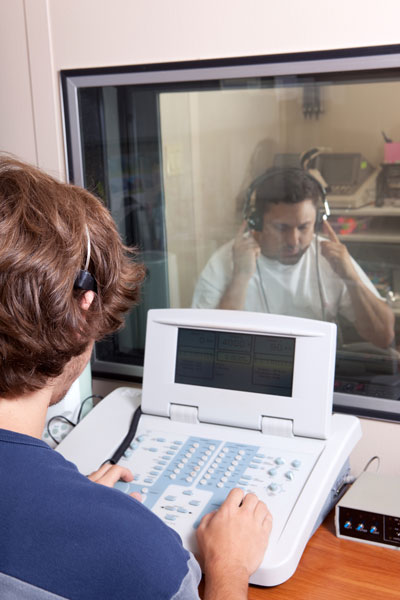The first step in diagnosing hearing loss is to undergo a hearing evaluation. A comprehensive evaluation consists of a series of individual tests that will help determine the extent and type of hearing loss. The audiologists at are skilled in conducting a number of hearing tests to help diagnose and treat patients with hearing loss.

Not all patients who experience hearing loss are aware of their condition. Symptoms tend to develop gradually over an extended period of time. Hearing tests may help detect a problem early, improving the chances of successful treatment.
Even individuals who do not suspect hearing loss should consider regular hearing tests once they reach the age of 50. And they’re not just for older adults; babies and toddlers should have their hearing tested in order to prevent delays in speech and language development should a hearing impairment exist.
Hearing tests are completely safe and painless. They are performed in a soundproof booth and results are plotted on a graph that shows the patient’s hearing response at different frequencies. This is called an audiogram, and will help the audiologist determine the best way to treat the hearing loss.
A typical hearing evaluation is comprised of a number of separate hearing tests.
Hearing Tests
Pure-Tone Testing
Air Conduction testing is used to measure a patient’s ability to hear sounds of various pitches and loudness. They are given headphones to wear and asked to identify a series of tones by raising a hand, pressing a button or responding verbally. The results are charted on an audiogram, a graph that shows the type, degree and configuration of the hearing loss by comparing pitch (frequency) with loudness (intensity). The pattern recorded will help the audiologist determine the individual’s hearing threshold.
Bone Conduction
Bone conduction testing is another type of pure-tone test that measures the inner ear’s response to sound. In this case, a headband is placed behind either ear. When stimulated, it produces a tonal vibration that travels to the cochlea via the skull. The patient’s response determines how well sound travels through different parts of their ear, helping the audiologist diagnose the type of hearing loss.
Speech Testing
Speech testing (word recognition) is used to estimate one’s ability to correctly repeat back words. This score is given as a percentage. Testing is usually completed at a comfortable loudness and completed in quiet. This score helps the audiologist identify any differences between ears and predict one’s outcome with hearing aids and/or a cochlear implant.
Tympanometry
Tympanometry is a test of the condition of the middle ear. It measures movement of the eardrum in response to air pressure in the ear canal; the results are recorded on a chart called a tympanogram. This is not a test of hearing, but rather it is used to help identify the type of hearing loss.
Acoustic Reflex Test
The acoustic reflex test measures involuntary muscle contractions of the middle ear, and is used to determine the location of the hearing problem (the ossicles, cochlea, auditory nerve, etc.) as well as the type of hearing loss.
Auditory Brainstem Response (ABR)
Auditory brainstem response (ABR) testing is used to determine whether a specific type of hearing loss – sensorineural – exists. It is often performed when an asymmetry between pure tone testing and/or word recognition was noted on the hearing exam. In an ABR test, electrodes are attached to the patient’s head, scalp or earlobes and they are given headphones to wear. Their brainwave activity is measured in response to sounds of varying intensities.
Otoacoustic emissions (OAEs)
Otoacoustic emissions (OAEs) are sounds generated by vibrations of the hair cells in the cochlea of the inner ear. OAE testing utilizes a tiny probe fitted with a microphone and speaker that is used to stimulate the cochlea and measure its response. Individuals with normal hearing will produce emissions. This helps determine the type of hearing loss. OAE testing is often included in newborn hearing screening programs.
